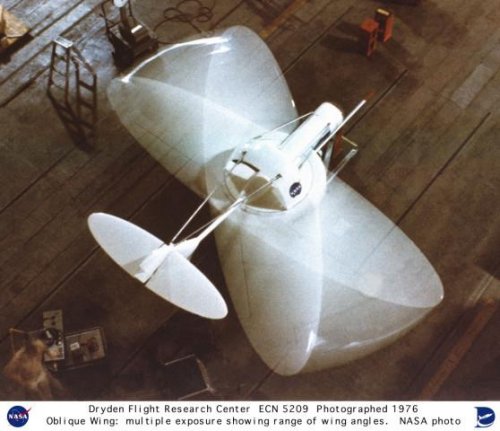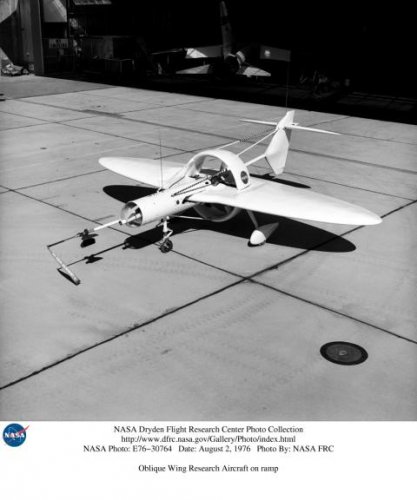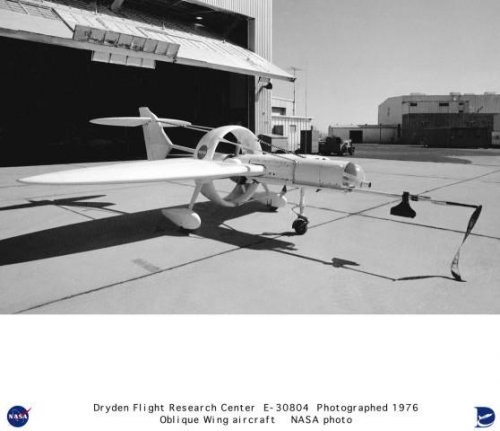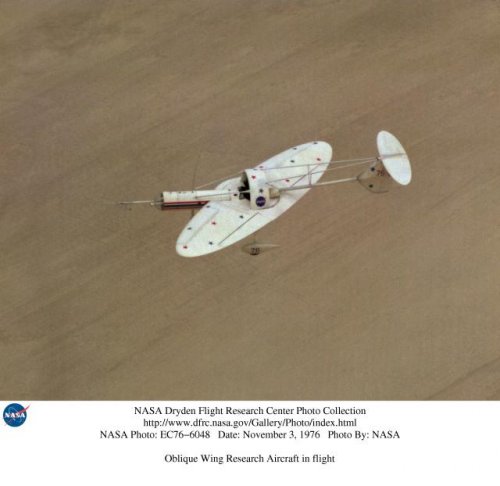- Joined
- 25 June 2009
- Messages
- 13,751
- Reaction score
- 2,943
In the mid-1970s, NASA was investigating the subject of Oblique Wing Research Aircraft.
Of course we have all seen the much-publicized NASA/Ames AD-1 "Skew Wing" or Rutan Model 35...
and a modified F-8 Crusader was considered at some point: https://www.secretprojects.co.uk/forum/index.php/topic,3285.0
But what of the OTHER Oblique Wing prototype, the unmanned OWRA proof-of-concept vehicle? It wasn't publicized much. Here is what NASA says about this strange-looking craft:
Four photos can be found on NASA sites, with the following captions (I'm attaching the low-res but providing links to the mid-size or high-res ones):
ECN-5209
April 28, 1976
In this 1976 composite photograph taken from above the Oblique Wing Research Aircraft (OWRA), the rotation capability of the wing is illustrated. The multiple exposure illustrates the limits of wing rotation from 0 and 45 degrees, along with the area swept-out during a full rotation.
https://www.nasa.gov/centers/dryden/multimedia/imagegallery/OWRA/ECN-5209.html
https://www.dfrc.nasa.gov/Gallery/Photo/OWRA/HTML/ECN-5209.html
E76-30764
August 2, 1976
This 1976 photograph of the Oblique Wing Research Aircraft was taken in front of the NASA Flight Research Center hangar, located at Edwards, Calif. In the photograph the noseboom, pitot-static probe, and angles-of-attack and sideslip flow vanes (covered-up) are attached to the front of the vehicle. The clear nose dome for the television camera, and the shrouded propeller for the 90-horsepower engine are clearly seen.
https://www.nasa.gov/centers/dryden/multimedia/imagegallery/OWRA/E76-30764.html
https://www.dfrc.nasa.gov/Gallery/Photo/OWRA/HTML/E76-30764.html
E-30804
August 20, 1976
This 1976 photograph of the Oblique Wing Research Aircraft (OWRA) was taken in front of the NASA Flight Research Center hangar, located at Edwards, Calif. In the photograph the noseboom, pitot-static probe, and angles-of-attack and sideslip flow vanes (covered-up) are attached to the front of the vehicle. The clear nose dome for the television camera, and the shrouded propeller for the 90-horsepower engine are clearly seen.
https://www.nasa.gov/centers/dryden/multimedia/imagegallery/OWRA/E-30804.html
https://www.dfrc.nasa.gov/Gallery/Photo/OWRA/HTML/E-30804.html
EC76-6048
November 3, 1976
Oblique Wing Research Aircraft in flight.
https://www.nasa.gov/centers/dryden/multimedia/imagegallery/OWRA/EC76-6048.html
https://www.dfrc.nasa.gov/Gallery/Photo/OWRA/HTML/EC76-6048.html
Today, the OWRA is on exhibit at the Udvar-Hazy Center in Chantilly, Virginia. You can see a walk-around in photos here:
http://www.primeportal.net/hangar/weichao_chen/owra_76/
In the first of these photos (extremely large and long to load, even with a very fast connection!) you can learn that the OWRA was powered by a 90hp McCulloch 4318B (O-100-1) engine. You will also learn its dimensions and performance (quite a fast little dude!), which I will not reproduce it because of the tedious m./ft. mph/km/h kg/lb. thing. See for yourself and pick the ones that suit you best!
ALSO: Desktop Aeronautics, Inc. produced in 2005 an excellent document on the subject entitled Oblique Flying Wings: An Introduction and White Paper, which can be read online here: http://www.desktop.aero/library/whitepaper/
or downloaded in PDF form from here: http://www.desktop.aero/library/ofwwhitepaper.pdf
POST-SCRIPTUM: I've just found out that Scott Lowther had a page on the OWRA, in which he presents not only the same photos and info, but also a great additional period photograph not found on NASA's sites, as well as a detailed plan. Go check it out!
http://up-ship.com/blog/?p=12121
Of course we have all seen the much-publicized NASA/Ames AD-1 "Skew Wing" or Rutan Model 35...
and a modified F-8 Crusader was considered at some point: https://www.secretprojects.co.uk/forum/index.php/topic,3285.0
But what of the OTHER Oblique Wing prototype, the unmanned OWRA proof-of-concept vehicle? It wasn't publicized much. Here is what NASA says about this strange-looking craft:
The Oblique Wing Research Aircraft was a small, remotely piloted, research craft designed and flight tested to look at the aerodynamic characteristics of an oblique wing and the control laws necessary to achieve acceptable handling qualities. NASA Dryden Flight Research Center and the NASA Ames Research Center conducted research with this aircraft in the mid-1970s to investigate the feasibility of flying an oblique wing aircraft. The oblique wing rotates about a pivot to allow the wing to be set at its most efficient angle for the speed it is flying. At higher speeds the wing takes advantage of the gains achieved by a swept wing while offsetting some of the drag producing disturbances. The oblique wing concept could result in transonic drag reduction and have the added benefit of producing corresponding fuel savings.
The aircraft's wing was capable of being skewed up to 45 degrees left wing forward. The aircraft was flown in two configurations, the short and long tail version. To aid in the remote piloting task, a television camera was mounted in the nose of the vehicle to provide forward looking views. Power was provided by a 90-horsepower, four cylinder, air-cooled, reciprocating engine.
The flight program was limited to three flights flown over Rosamond dry lakebed at Edwards Air Force Base, of approximately 1 hour each. After the first flight, longitudinal stability problems required a configuration change. The tail was moved back three feet and this configuration was used for the last two flights. Maneuvers were performed at wing skew angles of 0 to 45 degrees. This program provided information which led to flight testing a piloted aircraft with an oblique wing, called the AD-1.
https://www.dfrc.nasa.gov/Gallery/Photo/OWRA/index.html
Four photos can be found on NASA sites, with the following captions (I'm attaching the low-res but providing links to the mid-size or high-res ones):
ECN-5209
April 28, 1976
In this 1976 composite photograph taken from above the Oblique Wing Research Aircraft (OWRA), the rotation capability of the wing is illustrated. The multiple exposure illustrates the limits of wing rotation from 0 and 45 degrees, along with the area swept-out during a full rotation.
https://www.nasa.gov/centers/dryden/multimedia/imagegallery/OWRA/ECN-5209.html
https://www.dfrc.nasa.gov/Gallery/Photo/OWRA/HTML/ECN-5209.html
E76-30764
August 2, 1976
This 1976 photograph of the Oblique Wing Research Aircraft was taken in front of the NASA Flight Research Center hangar, located at Edwards, Calif. In the photograph the noseboom, pitot-static probe, and angles-of-attack and sideslip flow vanes (covered-up) are attached to the front of the vehicle. The clear nose dome for the television camera, and the shrouded propeller for the 90-horsepower engine are clearly seen.
https://www.nasa.gov/centers/dryden/multimedia/imagegallery/OWRA/E76-30764.html
https://www.dfrc.nasa.gov/Gallery/Photo/OWRA/HTML/E76-30764.html
E-30804
August 20, 1976
This 1976 photograph of the Oblique Wing Research Aircraft (OWRA) was taken in front of the NASA Flight Research Center hangar, located at Edwards, Calif. In the photograph the noseboom, pitot-static probe, and angles-of-attack and sideslip flow vanes (covered-up) are attached to the front of the vehicle. The clear nose dome for the television camera, and the shrouded propeller for the 90-horsepower engine are clearly seen.
https://www.nasa.gov/centers/dryden/multimedia/imagegallery/OWRA/E-30804.html
https://www.dfrc.nasa.gov/Gallery/Photo/OWRA/HTML/E-30804.html
EC76-6048
November 3, 1976
Oblique Wing Research Aircraft in flight.
https://www.nasa.gov/centers/dryden/multimedia/imagegallery/OWRA/EC76-6048.html
https://www.dfrc.nasa.gov/Gallery/Photo/OWRA/HTML/EC76-6048.html
Today, the OWRA is on exhibit at the Udvar-Hazy Center in Chantilly, Virginia. You can see a walk-around in photos here:
http://www.primeportal.net/hangar/weichao_chen/owra_76/
In the first of these photos (extremely large and long to load, even with a very fast connection!) you can learn that the OWRA was powered by a 90hp McCulloch 4318B (O-100-1) engine. You will also learn its dimensions and performance (quite a fast little dude!), which I will not reproduce it because of the tedious m./ft. mph/km/h kg/lb. thing. See for yourself and pick the ones that suit you best!
ALSO: Desktop Aeronautics, Inc. produced in 2005 an excellent document on the subject entitled Oblique Flying Wings: An Introduction and White Paper, which can be read online here: http://www.desktop.aero/library/whitepaper/
or downloaded in PDF form from here: http://www.desktop.aero/library/ofwwhitepaper.pdf
POST-SCRIPTUM: I've just found out that Scott Lowther had a page on the OWRA, in which he presents not only the same photos and info, but also a great additional period photograph not found on NASA's sites, as well as a detailed plan. Go check it out!
http://up-ship.com/blog/?p=12121




